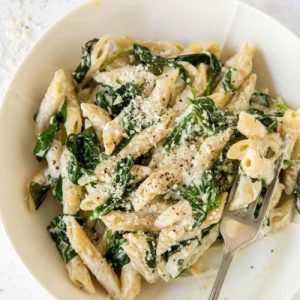
Spinach and Ricotta Pasta
A quick, creamy pasta dish made with tender penne, fresh spinach, and creamy ricotta cheese. Finished with Parmesan and a hint of nutmeg, this recipe delivers comfort and nutrition in under 30 minutes.
Equipment
- 1 Large Pot (for pasta)
- 1 Colander (for draining pasta)
- 1 Large skillet or sauté pan
- 1 wooden spoon (or spatula)
- 1 measuring cup (for pasta water)
- 1 Chef’s knife (for garlic)
Ingredients
- 10 ounces penne rigate pasta
- 2 tablespoons unsalted butter
- 3 cloves garlic minced
- 6 ounces fresh spinach
- 8 ounces ricotta cheese
- 1 tablespoon grated Parmesan cheese plus more for topping
- Pinch of ground nutmeg to taste
- Salt to taste
- Black pepper to taste
Instructions
- Cook the Pasta: Fill a large pot with water and bring it to a rolling boil over high heat. Add a generous pinch of salt to season the water—this helps the pasta absorb flavor while cooking. Once the water is boiling, add the penne rigate and stir to prevent sticking. Cook the pasta according to the package instructions until al dente (firm to the bite but cooked through). Before draining, carefully scoop out about 1 cup of the pasta water and set it aside. Drain the pasta in a colander and keep it warm.
- Sauté the Aromatics: In a large skillet or sauté pan, melt the unsalted butter over medium heat. Once the butter starts to bubble, add the minced garlic. Stir and let it cook for about 30–60 seconds, just until it becomes fragrant and lightly golden (be careful not to burn it). This creates a flavorful base for the sauce.
- Wilt the Spinach: Add the fresh spinach leaves directly into the skillet with the garlic and butter. Toss gently with tongs or a spoon, allowing the spinach to wilt down. This should take about 1–2 minutes. The spinach will reduce in volume significantly, releasing some natural moisture that blends into the sauce.
- Incorporate the Ricotta: Once the spinach has softened, stir in the ricotta cheese. The ricotta will melt into the warm pan, creating a creamy, velvety base for the pasta sauce. Keep the heat on medium and stir continuously to ensure the ricotta blends smoothly with the garlic and spinach.
- Combine Pasta and Sauce: Add the cooked pasta directly into the skillet with the ricotta-spinach mixture. Pour in about ¼ cup of the reserved pasta water and gently toss everything together. The starchy water helps the ricotta sauce cling beautifully to the pasta. Stir continuously for 2–3 minutes until the pasta is evenly coated and creamy. If the sauce feels too thick, gradually add another splash (up to ¼ cup) of pasta water until you reach your desired consistency.
- Season and Enhance: Sprinkle in the grated Parmesan cheese, a pinch of ground nutmeg, and season with salt and freshly ground black pepper. Stir well so the flavors combine. The nutmeg adds a subtle warmth, while the Parmesan deepens the savory flavor. Taste the pasta and adjust seasoning if needed.
- Serve and Enjoy: Remove the skillet from heat and portion the pasta into serving bowls. Top with extra Parmesan cheese, if desired, for added richness. Serve warm as a comforting main dish. Pair it with a crisp green salad or a slice of garlic bread for a complete meal.
Notes
- Reserve pasta water before draining—it helps loosen the sauce and makes it silky.
- Use fresh spinach for the best flavor, but frozen spinach (thawed and drained) works in a pinch.
- Ricotta adds creaminess without being heavy; full-fat is richer, but part-skim is lighter.
- A small pinch of nutmeg goes a long way—don’t overdo it.
- Parmesan balances the creaminess with a salty, savory kick.
- Adjust sauce thickness with more or less pasta water, depending on preference.
- Best served immediately, while the sauce is warm and creamy.
- Can be made vegetarian-friendly by ensuring Parmesan is rennet-free.
- Works with different pasta shapes like fusilli, rigatoni, or farfalle.
- Pair with a light side salad to balance the richness.